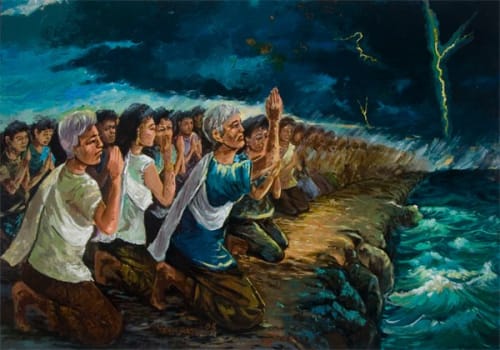Vann Nath evolves visual art practices regardless, or, in some cases, in spite of what is absent.
Vann Nath is one of Cambodia's most honored figures. It was his training as a sign painter in Battambang before imprisonment that kept him alive during captivity. His jailors spared his life so that he could be put to work painting and sculpting portraits of Pol Pot. Paintings depicting scenes he witnessed in S-21 hang in Toul Sleng Genocide Museum today, serving as one of the few public reminders of the regime's brutality.
Whereas Vann Nath typically paints specific moments of violence and despair, his painting included in Forever Until Now is unique in that it conveys collective hope. A mass of traditionally dressed Cambodian people kneel at the edge of stormy waters, raising their hands into the lightening streaked, moody sky. His treatment of paint blurs the crowd in the distance, evoking a dizzying infinity of people praying for peace.
The artist describes the painting as “a reflection on the character and behavior of Khmer people.” He says, “We practice prayer when we need something. We pray for peace. We don't want foreign invasion and vise versa. We want to live in peace.”
Vann has relentlessly advocated for justice for the victims of Khmer Rouge atrocities through his writings, paintings, and interviews. From 2001 to 2002 he worked intensively with Cambodian filmmaker Rithy Panh in the making of his award-winning documentary S-21: The Khmer Rouge Killing Machine.
His life and work have been recognized through many awards and media coverage around the world. His memoir A Cambodian Prison Portrait: One Year in the Khmer Rouge's S-21 was published in 1998. Group exhibitions include The Legacy of Absence, Reyum, Phnom Penh (2000), The Spirit of Cambodia, Providence College USA (2003) and his solo exhibition Transfer at Bophana Audiovisual Center, Phnom Penh (2007).
